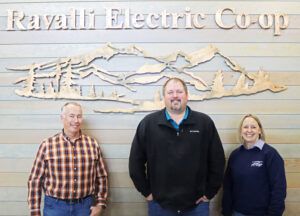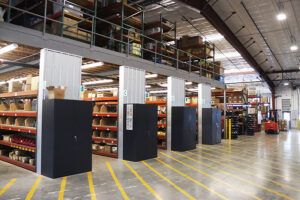
by John Dowd
Early this year, western Montana was hit with a record cold spike that strained the area in many ways. One such way was the impact on the power supply, according to representatives from Ravalli Electric Co-op. The cold spike brought to light future power concerns, highlighting the issues that could result from decisions about the area made by federal and environmental groups.
According to Mark Grotbo, the general manager of Ravalli Electric Co-op, many people may not truly be aware of where their power comes from, and how it gets here. For example, over 85% of the power that comes into the Bitterroot Valley is produced by hydroelectric dams. That hydroelectric power comes predominantly from the Snake River dams in the Columbia River basin.

During this year’s cold snap, the area’s power production relied on power from those dams, as the other options just could not keep up. “If those dams weren’t there, it would have been cold and dark for a lot of people,” said Grotbo. According to the co-op’s manager of operations, Kyle Kearns, the county came very close to a blackout. To explain this, Grotbo spoke on the matter, saying “the thing many people don’t understand about power is that it has to be made as it’s used.”
In other words, the way electricity works on a large scale, it cannot be stored. It would be like having a system of pipes with water flowing through. According to Grotbo, in the hypothetical system, water is piped out to homes in the area. The pressure and flow rate are even comparable between the two services. However, unlike water, when an area loses effectiveness, the power does not trickle. It stops completely. To get it started back up again takes more power than it did to sustain it in the first place. Individual areas then need to be brought back online, one at a time, terracing back up to regular output. This last cold snap brought the system right up to that peak edge.
According to Kearns, “The system has to be built out to handle those peaks.” Even though their system may seem like overkill, he said that if it is not built to handle the worst of times, then it would always shut down at those times.
The concern for the future of area power stems from a consideration by the current administration and environmental groups to close down and remove the dams in the basin. Co-op representatives believe this to be a very short-sighted idea, though perhaps with good intentions in mind.
With such a high percentage of power being purchased by the co-ops in northwestern Montana produced by hydroelectric dams, removing those dams would put that weight of production onto areas that just are not there to pick up the slack. Part of this has to do with the nature of the area. As Grotbo explained, peak season for the co-op is the cold and dark of winter, when people are heating their homes and using more lights.
According to Grotbo, this is also the time of year when alternative power sources, such as wind and solar, are significantly less productive. In dry southern desert-type environments, this is not an issue, as there is a much more consistent source of solar and wind, even in the winter months. In Montana, where the nights are longer, and the wind less active, these cannot be relied upon, according to Grotbo.

When speaking on the affordability and feasibility of these alternative energy sources, Grotbo said the cost is exorbitant and not at all practical in this area yet. As for clean energy, Grotbo also expressed that “we’re the envy of the rest of the nation,” when it comes to a low carbon footprint energy. According to Grotbo, there is virtually no waste produced from hydroelectric, unlike nearly every other form of power production. The only other clean solution could be nuclear, but the co-op representatives said that form of power production just does not have a strongly established infrastructure in the area.
The other issue is power storage. As Grotto stated, power storage is not practical on the scales they are dealing with. To give an example, Grotbo said a one megawatt battery, that would store and put out enough power for just four hours, costs well over $4 million. A single of the co-op’s substations was measured putting out roughly 10 megawatts during the peak of the cold spike early last month. The coop operates seven substations. “Think of how many batteries you would need to cascade, going forward there,” said Grotbo.
To put that into perspective regarding times of high use, like this last cold spike, Kearns and Grotbo spoke about the power they consume and send out to customers. The co-op typically pays $40 per megawatt hour, wholesale, and generally consumes about 18 megawatts on average. During that cold snap, it cost their power provider, Bonneville Power Administration (BPA), $1,400 per megawatt hour to meet the demand. In that period the co-op peaked at 55 megawatts. “We were pretty fortunate during that cold snap,” said Kearns. “Once it gets cold, it tests your system,” added Grotbo.
On top of all that, the need for power is only rising. Kearns said that this year the co-op was up 23% from last year on total power consumed during this cold snap, which was an all-time high. Co-op manager of communications, Melissa Greenwood, attributed that to “more people, more demand on the system.”
To meet that growing need, Kearns added that the co-op is working to expand the Grantsdale substation, and will then work on expanding the one in Stevensville, among other improvements and maintenance.
In fact, according to Kearns, a lot of what they do is maintain. Their state of the art system allows them to see issues in real time on monitors in the office. The system will automatically notify them of areas that are down, about to go down, or displaying other issues. These notifications can be seen by any of the linemen and the team in the office, allowing them to stay on top of the maintenance before systems shut down. “It is always better, faster and cheaper to stay ahead of an outage,” said Grotbo. However, Grotbo also pointed out, “You can’t build a gold-plated system.” The co-op tries to keep their costs down for their members. That is why they operate with a board, which has to approve everything. “They are my bosses,” said Grotbo.
Fortunately, the co-op is not alone when big issues like the cold snap happen. They have mutual aid agreements with all the co-ops across the state, of which there are 25 in total. This means anytime they have a big issue and get overwhelmed, help is not far away.
Ravalli Electric Co-op was the first electric co-op in the state, and services 1,346 miles of line in the valley. Their purpose was to get power to the rural areas, as prior to their existence only the big profitable areas like major towns and cities were receiving power. In order to get electricity to farmers and ranchers on the fringe without costing an exorbitant amount, the co-op was created.
As for where that electricity comes from, the co-op does not make its own power, which again comes from the hydroelectric dams further west. NorthWestern Energy brings in the power through major transmission lines. This is called wheeling the power. This power is then picked up and sent out into the various areas of the county to the co-op’s substations and from there it goes out into the community. NorthWestern Energy covers the main towns and cities in the area, and everything else in the valley is powered by the co-op.
The co-op moved into a new building at Bell Crossing in 2019, which they explain has been a godsend. “We’re very fortunate with the way it all worked out,” said Grotbo. He described how they got moved into the new space right before the pandemic, which kept their building costs down and allowed them the space for everyone to continue to come to work. It has also landed them with a massive state of the art facility. They say it streamlined their process, and has created room for other improvements in the way they interact with customers.
One of these improvements has been customer access to their SmartHub, which is an app and online portal that allows customers to see everything about their account. They can view info about maintenance, their power usage and bill tracking. According to Greenwood, “it’s a complete home energy analysis.” Customers can also go online to view planned outages, message concerns and time estimates as well as view a map of outages.